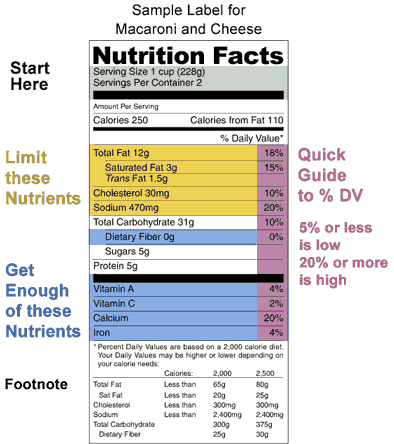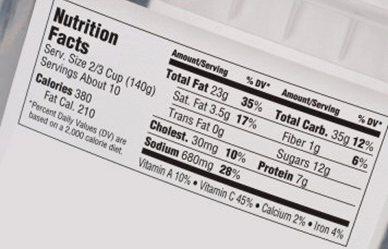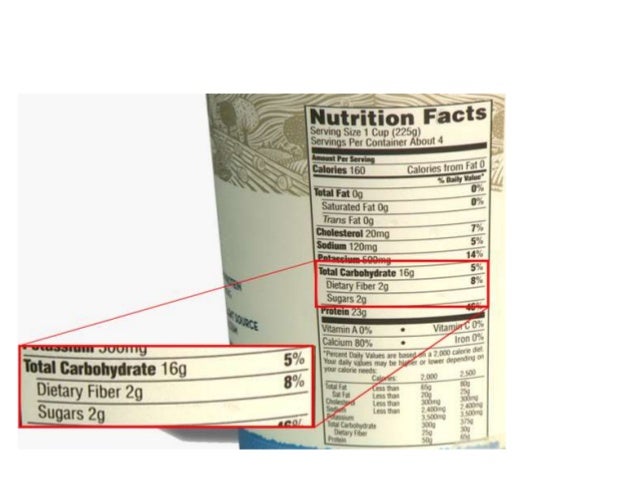41 reading labels on food products
How to read food labels | healthdirect How to read the Nutrition Information Panel. The Nutrition Information Panel tells you the size of a standard serving of the product and which nutrients are contained in that serving. You can use the label to compare the product with what's in similar packaged foods. Look out for information about: Energy: A kilojoule is a measure of energy. How to Read a Food Label | Food Allergy Research & Education Starting Jan. 1, 2023, allergen labeling of sesame will be required under the Food Allergy Safety, Treatment, Education and Research (FASTER) Act of 2021. Ingredients and manufacturing processes can change without warning. Make a habit of carefully reading labels to ensure you avoid any potential allergens. "May Contain" Statements
Understanding Food Labels - Go Dairy Free This handy quick guide includes the essentials to understanding food labels for dairy-free diets. Click on any of the links or images below to get information on understanding food allergen labeling (including how to spot milk when it isn't clearly noted), foods and all types of other products where dairy may hide (yes, even in paint and ...
Reading labels on food products
Food Label Reading - What You Need to Know - Drugs.com Calories per Gram: Many labels tell you how many calories are in each gram of the major parts of food. Fats contain 9 calories per gram, carbohydrates contain 4, and proteins contain 4. High fat foods can lead to weight gain because fats have more than twice the calories of other types of food. How To Read Food Labels - 10 Tips | Pritikin Program For Eating Right A serving of oil spray, for instance, is .25 grams. That's about 120th of an ounce - far less than most people could, or would, spray on a pan with even just one squirt. 4. Check the amount of servings per package. Decades ago, many products were in fact single servings. A bottle of cola was one serving. One small candy bar was one serving. Food Labels | Nutrition.gov Food labels can help you make healthy choices when buying food in grocery stores or restaurants. Labeling Organic Products. USDA, Agricultural Marketing Service, ... Find education materials that make it easy to understand and use the Nutrition Facts Label including: Read the Label Youth Outreach Materials; Gluten and Food Labeling;
Reading labels on food products. How To Read Food labels for Sugar | My Sugar Free Kitchen On the label check the sugars in the nutrition panel. 5g/ml or less of sugar per 100g/ml = this would count as low sugar content. It means 5% of the ingredients are sugar Between 5g/ml and 20g/ml of sugar per 100 grams = medium sugar content. With 20ml of sugar per 100 ml, this means the product is 20% sugar…not so good. Food Allergy & Anaphylaxis | Food Labeling | Food Labels Read labels each and every time before eating any food product. Ingredients can change over time, or may vary depending upon the size of the product (e.g. jumbo vs snack size). Statements advising that products may/might contain or are made in shared facilities with a food allergen are purely voluntary. Food Labeling & Nutrition | FDA Food labeling is required for most prepared foods, such as breads, cereals, canned and frozen foods, snacks, desserts, drinks, etc. Nutrition labeling for raw produce (fruits and vegetables) and... How to Understand and Use the Nutrition Facts Label | FDA For certain products that are larger than a single serving but that could be consumed in one sitting or multiple sittings, manufacturers will have to provide "dual column" labels to indicate the...
The Importance of Reading the Food Label and Nutritional Facts The Importance of Reading Food Labels This information does two things: The Basics of Reading a Nutrition Label 1. Serving Size 2. Calories per Serving 3. Percent Daily Values 4. Nutrient Contents 5. Vitamins & Minerals 6. Ingredient List Putting it All Together Reading food labels makes a big difference when it comes to your family's health. Why Is Reading Food Labels Important? | livestrong Provides Key Information The nutrition label provides key information such as serving size, calories, total fat, saturated fat, cholesterol, protein, carbohydrate and vitamin content. The label also contains a list of the ingredients. This information helps you stay on track with your daily targets. How To Read Food and Beverage Labels | National Institute on Aging There are three types of product dates commonly printed on packaged foods and beverages: "Sell by" tells how long the manufacturer suggests that a store should sell items such as meat, poultry, eggs, or milk products. Make sure you buy by this date. "Use by" tells how long items will be at peak quality. Reading Labels - World Action on Salt & Health Checking food labels lets you compare brands and varieties or flavours of products and choose those that are lower in salt. Adding up the amount of salt will also give you an idea of how much salt you are eating throughout the day. Foods high in salt have more than 1.5g salt / 100g (or 0.6g sodium / 100g)
PDF Lesson 10 Decoding Food Labels - Johns Hopkins University Decoding Food Labels [Lesson Duration: 50 minutes] Lesson Overview Explore the common types of food labels and how to interpret them. Identify who regulates and verifies the accuracy of food labels. Food products are labeled with words like "natural" and "humane," and some are certified as USDA Organic or gluten free. How to Read a Food Label - WebMD To be considered high in fiber, a food must contain least 5 grams per serving. Fruits, vegetables, and whole grains provide fiber. Fat. Fat has more calories per gram than carbs or protein, and all... How to Read a Food Label | Atkins How to Read a Food Label To ensure that consumers know what is in the foods they buy, the Food and Drug Administration (FDA) requires that the packaging of every manufactured food product display certain information. Ingredients must be listed in descending order of weight. Labeling must also include a Nutrition Facts panel. How to Read a Nutrition Label: The Path to More Empowered Eating Choices Nutrition and Percent Daily Value (DV) Remember that companies must disclose what their food provides you in nutrients. To figure this out, multiply the number of servings you consumed (or plan to consume) by the calories and grams of fat, sodium, sugar, and carbohydrates provided on the food label.
Reading food labels: Tips if you have diabetes - Mayo Clinic Reading food labels can help you make the best choices. Start with the list of ingredients When you're looking at food labels, start with the list of ingredients. Keep an eye out for heart-healthy ingredients, especially those that are less processed, such as whole-wheat flour, soy and oats.
Learning To Read Labels :: Diabetes Education Online On a nutrition food label, subtract the fiber from the total carbohydrate amount. When you read food labels, the grams of sugar are already included in the total carbohydrate amount, so you do not need to count this sugar amount separately. The grams of sugar listed include both natural sugars, from fruit or milk, and added sugars.
Reading Labels For Clean Eating | The Gracious Pantry Almonds. Walnuts. These are all examples of what clean foods are. Think of it this way. You want to purchase INGREDIENTS. Not prepared foods. Yes, this takes a bit of forethought and planning. Clean eaters do cook a lot, and most of them love it. Just know that over time, the cooking and prep work do become routine.
Food Labels | CDC All the numbers on this label are for a 2/3-cup serving. This package has 8 servings. If you eat the whole thing, you are eating 8 times the amount of calories, carbs, fat, etc., shown on the label. Total Carbohydrate shows you types of carbs in the food, including sugar and fiber. Choose foods with more fiber, vitamins, and minerals.
13 Misleading Food Label Claims and How Not to Be Tricked Products labeled sugar-free may also have higher levels of fat in order to make up for the taste and texture that is lost when sugar is removed. 2. Label Says "Fruit-Flavored" Reading on a label that a product is fruit-flavored suggests that the product is flavored with real fruit. This, however, is not necessarily the case.
How to read food labels | Food safety at home | NZ Government Reading food labels helps you know which food and drink is right for you. Here's what each part of the label means and what to do if you find a problem with a food label. 'Use by' or 'best before' dates (date marks) Date marks indicate how long food can be kept before it starts to deteriorate or becomes unsafe to eat.
Understanding Food Nutrition Labels | American Heart Association Learn what to look for on the label. 1 - Start with the serving information at the top. This will tell you the size of a single serving and the total number of servings per container (package). 2 - Next, check total calories per serving and container.
Reading Food Labels | ADA - American Diabetes Association Put food labels to work. The Nutrition Facts labels on foods are really the key to making the best choices. We'll cover the basics so that these labels make shopping easier for you. You've heard it all. From carb-free to low-carb, to whole and empty carbs, it's hard to know what it all means. Blood sugar highs and lows aren't always ...
Reading food labels - Food Allergy Education How to read food labels that meet the new PEAL law Under the new PEAL law, common food allergens are to be listed with the plain English name alongside the actual ingredient name. This is shown in the label example below. In the statement of ingredients, declarations must: Be in bold font. Have bold font contrasting distinctly with other text.
Food Labels | Nutrition.gov Food labels can help you make healthy choices when buying food in grocery stores or restaurants. Labeling Organic Products. USDA, Agricultural Marketing Service, ... Find education materials that make it easy to understand and use the Nutrition Facts Label including: Read the Label Youth Outreach Materials; Gluten and Food Labeling;
How To Read Food Labels - 10 Tips | Pritikin Program For Eating Right A serving of oil spray, for instance, is .25 grams. That's about 120th of an ounce - far less than most people could, or would, spray on a pan with even just one squirt. 4. Check the amount of servings per package. Decades ago, many products were in fact single servings. A bottle of cola was one serving. One small candy bar was one serving.
Food Label Reading - What You Need to Know - Drugs.com Calories per Gram: Many labels tell you how many calories are in each gram of the major parts of food. Fats contain 9 calories per gram, carbohydrates contain 4, and proteins contain 4. High fat foods can lead to weight gain because fats have more than twice the calories of other types of food.














Post a Comment for "41 reading labels on food products"